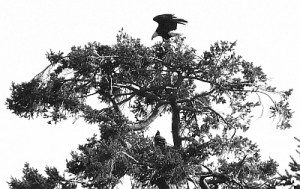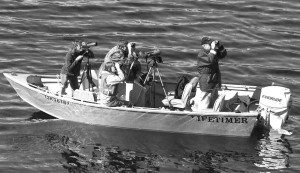DCA ANNUAL FUNDRAISING DRIVE:
YOU MADE IT HAPPEN!
October is a great time for harvesting and DCA is no exception: early in the month Conservancy sent out ‘seeds’ in the form of over 400 letters to established and potential supporters. Donations are already coming in, and will continue for the next few months. Last year, a similar letter brought in close to $25,000!
This is DCA’s annual fundraising drive, and it provides our financial foundation. Of all the funding sources we rely on, these gifts from individuals are the most important. In fact, your gift brings us much more than its immediate dollar value. Here’s why:
Reliability:
Other funding sources such as government or foundations regularly change their priorities or, especially these days, cancel funding programs entirely. Individuals and small businesses are more consistent.
Simplicity:
Institutional funding is often bound up with complex bureaucracy that takes inordinate amounts of volunteer time and energy. Also, it usually has strict limitations on what can and can’t receive funding, which sometimes means our most pressing needs don’t get support. On the other hand, donations from the community can be more freely directed to areas of need..
Exponential power:
When we apply for grants, we need to show community support and to provide matching funds. Your donations supply both of these. Without your gifts, we’d have a hard time getting further funds.
Encouragement:
The annual fundraising drive brings in gifts ranging from ten dollars to tens of thousands of dollars. Each of these donations, big and small, tells us that we have your support, that there is a groundswell of people in our community who value what we do and trust us to do it well. Do not underestimate how essential this is for DCA’s hard-working volunteers!
Thank you
to everyone who has donated to the 2010 fundraising drive. If you did not get a letter and are considering a donation, please contact us by phone or email at…..
In return for the trust you place in us, we pledge to work with enthusiasm, inspiration and the utmost professionalism to fulfill our mandate — to preserve, protect and enhance the quality of the natural and human environment of Denman Island.
BALD EAGLE STEWARDSHIP ON DENMAN

While coastal trees all over the Comox Valley are continuously being cut to accommodate human activities, Denman’s coastline still accommodates nesting eagles. Consequently, eagles are really taking advantage of those big old trees. Of the 29 known nests on Denman this year, 19 showed signs of eagle activity in the spring. By early August, at least 18 juvenile eagles had fledged from at least 14 of these nests.
Denman Conservancy Association Newsletter November 2010
Eagle watching on Denman was a very popular activity this year. Throughout the spring, photographers from all over Vancouver Island made repeated trips to snap close-up eagle images at the Chrome Island-lookout nest in Boyle Point Park. Behaviours, diet and other activities of these tolerant parents were recorded on film. Other photographers commented that they took literally thousands of eagle photos at their own favourite Denman sites.

Eagle observations also produced significant data. Denman’s nest tree stewards kept a lookout for eagle activity at nests in the spring. Then, in mid-summer, they checked eagle productivity or the number of young that fledged from each nest. Many remarkable behaviours were witnessed, from adults forcefully encouraging young to fly, to invading eagles attacking another nest and its offspring. In addition, Kevin Behrens captained an eagle-monitoring marine-cruise. This cruise also produced great data, including a new nest with eaglets, as well as, activity at a nest thought to be abandoned. Rough weather limited the cruise to the SW shoreline, but overall, 27 adults and 6 juveniles were observed.
Stewards and interested islanders
are invited to gather for Eagle Night, November 26th, 7:30 at the Arts Centre. Eagle Night is a chance to view the year’s monitoring results, chat with Hornby Island’s eagle author, Doug Carrick, view photos and share interesting eagle observations.
*********
Contributors to this Newsletter: Laura Busheikin, David Freeman, Jenny Balke, J Thornton, Keith Walker
Many thanks to all those who contributed to eagle stewardship, including Denman’s 22 nest-tree monitoring stewards, eagle photographers Dennis Forsyth and Mike Yip, cruise organizers Kevin and Janet Bengough, eagle project assistants Galen Malthouse and Elizabeth Chapman and all Denman islanders for sharing their island with the eagles.
LANDKEEPERS PROGRAM
The Denman Conservancy Landkeepers Program is about to begin. Modelled on the highly successful Streamkeepers Program that protects salmon bearing streams, the Landskeepers Program trains islanders to look after lands under Conservancy ownership or management, such as the Lindsay-Dickson forest. Landkeepers will be extensively trained, and will be assigned an area of the island that they will care for, manage, and protect.
The program will begin as soon as the program coordinator is hired. Training consists of a guided hands-on project to complete base-line studies of the flora and fauna in the Railway Grade Marsh and the Settlement Lands. A wide range of skills such as plant and animal identification, invasive plant control, GPS usage etc. will be taught by experts, with class room discussion and study followed by field work. The training class will work as a team to prepare a management plan for the Railway Grade Marsh. Upon graduation of the class, the real fun begins when the skills learned are applied to other areas on the island.
An additional benefit to the island will occur when the Ministry of the Environment asks Islanders to help decide how the new park on the North Lands will be managed. The skills learned in the Landkeepers Program are the same skills that the Island will need to determine how the new park will evolve.
Come and be a part of this exciting new program. In order to determine the size of the program, we need to know how many people are interested. All ages welcome. Call J Thornton or John Dillon to register your interest.
Denman Conservancy Association Newsletter November 2010


